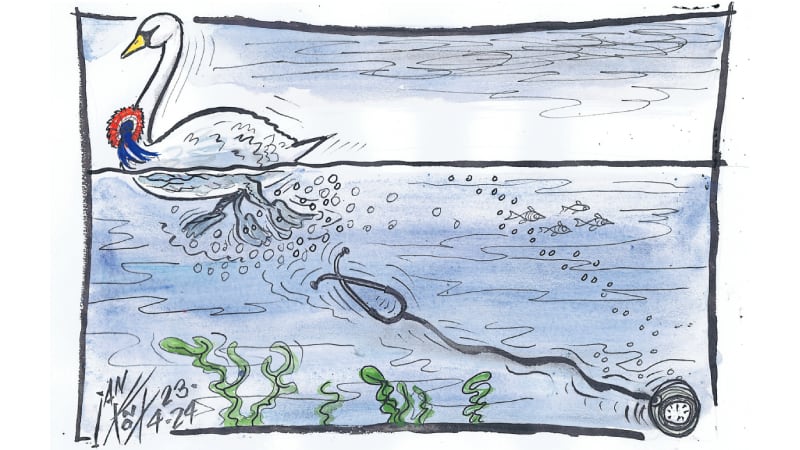People should be cautious about altering, pulling down or covering up the statues and monuments of bygone eras, whether they relate to John Mitchel, Seán Russell, the Duke of Wellington or Sir Edward Carson.
If explanations are felt to be required, an information plaque beside the monument should be sufficient.
John Mitchel, through his famous ‘Jail Journal’, did much to promote the separatist ideal, and it is that he is remembered for, not the aberration of his espousal of the Confederate cause or slavery. It should not be necessary to have to explain that, any more than it is necessary to state that Wellington is not honoured today for his Indian campaigns.
The dignified statue of Seán Russell in Clontarf is a reminder of a strand in our history. We do not have to approve of it, but nor do we have to blot it out.
Brian Patterson (July 29) refers to Wellington as ‘the racist, anti-semite war criminal’. That is not the judgment of either history or historians, not just British ones, so why the compulsion to resort to the most gratuitously offensive adjectives he can find? The Spanish uprising against the French in 1808, which Sir Arthur Wellesley was sent to support, was seen as a war of national liberation, but it fell very short of that ideal in reality, including on occasions after a victorious siege when British troops were allowed to run amok and engage in plunder and slaughter. Despite those black marks, Wellington played a huge part in freeing Europe from Napoleonic despotism first by 1814 and then at Waterloo, for which he received tributes from rulers all over Europe. After Napoleon, he was probably the most famous military commander of the 19th century.
What Wellington did or did not say about Ireland matters very much less than what he did for it. He was never ‘bitterly anti-emancipation’. In 1800, he attributed George III’s opposition to emancipation to the king’s derangement of mind. Eventually, he had not just to face down George IV, but also a considerable section of his own class in the Anglo-Irish ascendancy that had formed Brunswick Clubs in 1828 to fight emancipation.
Among his motivations was the desire to prevent potential large-scale bloodshed in his native land.
Yes, he was wrong to restrict the franchise and to oppose parliamentary reform, but, even so, the door to the repeal of the conquest had been unlocked.
He deserves better of Irish opinion today. There is little basis for Irish unity any time soon, if one’s concept is uncritically denigrating the high achievers and achievements of traditions outside one’s own.
MARTIN MANSERGH
Tipperary, Co Tipperary
Belfast should accurately respect and reflect different experiences of city’s life
In 2012, as Mayor of Belfast, I helped to open one of Belfast’s leading tourist attractions, Titanic Belfast. In my remarks, I referenced the different experiences of life with regards to and indeed inside the Harland and Wolff Shipyard – not least my own parish which lived in its shadow and often fell victim to violence, pogrom and attack initiated from within its confines.
In the intervening years, millions of people have visited what is now known as the ‘Titanic Quarter’, an area transformed into a tourism, education, entertainment and [limited] residential area.
As the mix of old and new continue to intertwine, sometimes imperfectly, sometimes with fantastic outcomes, the sad reality remains that only one narrative about the history of this part of Belfast prevails. The history of shipbuilding and ‘The Yard’ are presented with all the fervour and spending of a Hollywood blockbuster – fair enough. But surely, in the context of reconciliation and the decade of centenaries, it would be a welcome step forward if a truthful reflection of the darker side of the H&W Shipyard was told to the many who visit the fantastic Titanic Belfast. Wouldn’t it be a positive advance if our civic leaders, in the welcome context of rebalancing the city and telling all our stories, took steps to remember those who were expelled from the shipyard because they were Catholic or trade unionists? I don’t think it would take another allocation of tens of millions of public monies to tell this story, address this imbalance and remember this particular experience.
As we prepare to mark the centenary of one of the major expulsions from Harland and Wolff and the subsequent pogroms carried out throughout Belfast, I think our city has reached a point where we can confidently and accurately respect and reflect the different experiences of life at that time.
Seanadóir NIALL Ó DONNGHAILE
East Belfast
Palestine is the country Britain invaded
In response to Andrew J Shaw – ‘Palestine is a mythical place’ (July 23) – I know I could write an essay of true facts but that would not convince anyone with Andrew’s mindset. So, as a final gesture and respect to Andrew, I will answer the question he poses to me – where do I consider Palestine is? That’s an easy one. Palestine is the country which Britain invaded, occupied, ethnically cleansed, planted and partitioned all by force and terror for 30 years 1918 to 1948 – creating what Churchill called our little Ulster in the Middle East. Don’t take my word for it there are many monuments in city hall praising British soldiers actions and bravery in ‘Palestine’ which proves it’s not a mythical place. Andrew implores me to encourage my Palestinian friends to grow up and then sit down and negotiate their future. Who with? Surely not the residents living in their former homes and land. Would Andrew negotiate if someone stole his home by force?
PETER McEVOY
Banbridge, Co Down
Ireland’s Nelson Mandela
I once spent a couple of hours in the adjacent chair to John Hume at a school prize giving. He was the guest speaker and I the vice chair of the board of governors. To say we had a memorable exchange that evening would be a gross exaggeration. No conflict, mind you, but a meagre exchange of chat.
He was due in Strasbourg in a couple of days but, mentally, he was already there. The fact that he was here at all was due in no small part to the persuasive qualities of our esteemed principal and John’s wife Pat. He performed admirably and left me with much to ponder. The man was driven and really too preoccupied for triviality like chat. He had more crucial fish to fry. Coincidentally, I’m reading a Nelson Mandela book Playing the Enemy and am struck this morning by the similarities in the two men. Equally focused, passionately committed and unafraid to face realities even to the point of speaking harshly when necessary. Much less committed to the goal of being liked than just being listened to. Others will pour out more compelling stories in the coming days but I would simply say that Nelson Mandela spent 27 years in prison developing the mindset that brought South Africa to an unlikely peace. John Hume must have been born with those same instincts and it may, one day, be said that Nelson Mandela became John Hume-like during his period of incarceration. Today’s heresy may well be tomorrow’s truth. RIP John.
KIERAN McMULLAN
Randalstown, Co Antrim







